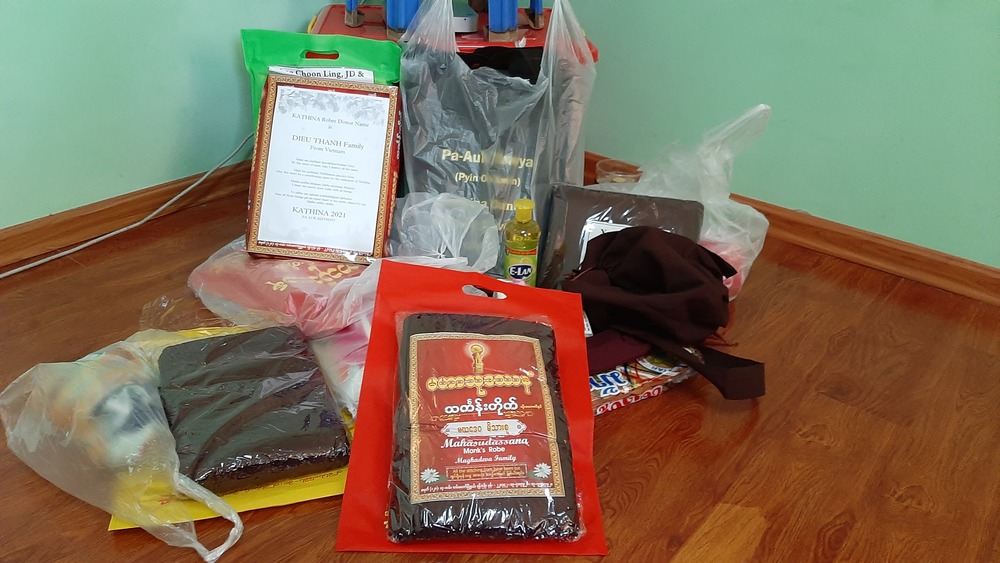Here are just some of the vinaya references with mixed references from BMC 1, BMC2 and PTS Mv
So, I asked my parents if I could become a monk at this Mahayana monastery, and they said, “No!” (You had to have your parent’s permission to join the monastery.)
“A son whose parents have not given their permission should not be given the
Going-forth. Whoever should give it: an offense of wrong doing.” — Mv.I.54.6
. For example, some of the pieces must be cut and then sewed together. This is especially true with the robe’s boarders. But some manufacturers want to just fold the fabric and sew it—creating a fake seam—because that reduces the time it takes to make the robe by about 1/3. But it actually renders the robe unusable.
So, the robes were in colors like a drab maroon or brown.
“Robes that are entirely blue (or green) should not be worn. Robes that are entirely
yellow … entirely blood-red … entirely crimson … entirely black … entirely orange …
entirely beige (§) should not be worn. Robes with uncut borders … long borders …
floral borders … snakes’ hood borders should not be worn. Jackets/corsets, tirīta-
tree garments … turbans should not be worn. Whoever should wear one: an offense
of wrong doing.” — Mv.VIII.29
Now at that time monks wore yellow robes, (the colour) of ivory,4 not cut up.5 People
looked down, criticised, spread-it about, saying: “Like the householders who enjoy pleasures
of the senses.” They told this matter to the Lord. He said: “Monks, robes that are not cut up
are not to be worn. Whoever should wear one, there is an offence of wrong-doing.” || 2 || 11 || (pts)
As for the pattern of our robes, the Buddha was walking near a paddy field one day, and he said to Ānanda, “Oh, this pattern is beautiful. All robes should look like this.” And so, that is the pattern of Theravāda monastic robes today. The pieces of cloth are sewn together so that they look just like a rectangular rice paddy field.
Then the Lord, having stayed in Rājagaha for as long as he found suitable, set out on
tour for Dakkhiṇāgiri.6 The Lord saw the field of Magadha,7 laid out in strips,1 laid out in lines,2 laid out in embankments,3 laid out in squares,4 and seeing this, he addressed the venerable Ānanda, saying:
“Now, do you Ānanda, see the field of Magadha laid out in strips . . . laid out in
squares?”
“Yes, Lord.”
“Are you able, Ānanda, to provide robes like this for the monks?”
“I am able, Lord.” (pts mv)
At an hour a day, it takes about five months to make robes.
According to Pv.XIV.1, these privileges apply both for the bhikkhu who has spread
the kaṭhina and for any bhikkhu who has approved the spreading of the kaṭhina. As
long as certain conditions are in place, these privileges extend until the end of the
cold season, five months after the end of the first Rains-residence. (BMC2)
we have a rule that upper robe should be four fingers from the bottom of the kneecap. And the lower robe should be eight fingers from the bottom of the kneecap.
1-2. I will wear the lower robe [upper robe] wrapped around (me): a training to be observed.
To wear the lower robe wrapped around means to wear the upper edge circling the waist, covering the navel, and the lower edge covering the kneecaps. This is called covering the “three circles.” The Commentary states that when one is standing, the lower edge should be not more than eight fingerbreadths below the knees, although if one’s calves are disfigured, it is all right to cover them more than that. (BMC 1, Sekhiya)
there’s a casualness about wearing the robes properly. The monks who have their arms exposed when out in the village , especially the right shoulder—these are monks that don’t follow the rules.
Sekhiya 3-4. I will go [sit] well-covered in inhabited areas: a training to be observed.(BMC 1)
One definitely should not wear monastic robes unless he or she is actually a monk.
reference coming later for *theyyasaṃvāsako
If you need something, you have to ask someone to give it to you—because you don’t touch money.
NP 18. Should any bhikkhu accept gold and silver, or have it accepted, or consent to its being deposited (near him), it is to be forfeited and confessed. (BMC 1).

